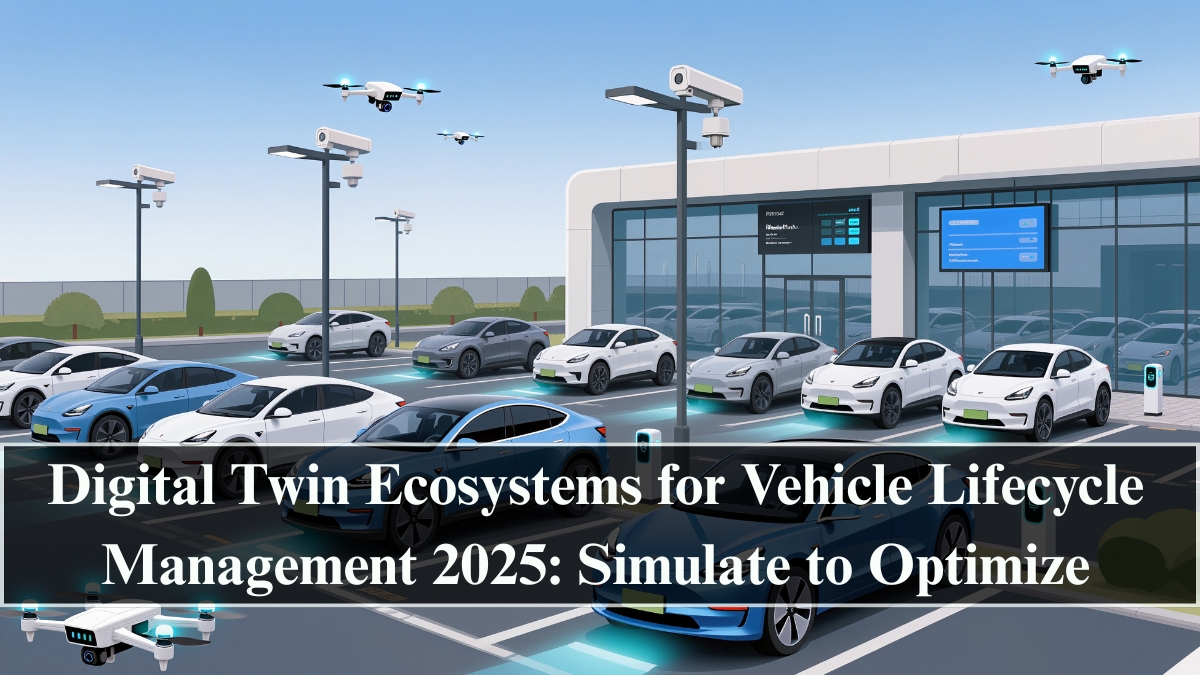In 2025, the automotive world has entered an era of precision, prediction, and performance — all powered by digital twin ecosystems. A digital twin is a virtual replica of a physical vehicle, continuously synchronized with real-world data to simulate, monitor, and optimize performance throughout its entire lifecycle.
From concept to end-of-life recycling, digital twins are redefining how vehicles are designed, built, and maintained. Automakers no longer rely on guesswork — they rely on data-driven models that mirror every nut, bolt, and algorithm of the real machine.

What Is a Digital Twin Ecosystem in Automotive?
A digital twin ecosystem is a comprehensive digital model that replicates not just the vehicle but the entire system around it — including its manufacturing process, environment, and usage. These models use real-time data from IoT sensors, AI analytics, and cloud computing to continuously update and simulate the physical asset’s behavior.
This ecosystem creates a “living” vehicle in the digital world that evolves as its real-world counterpart operates. It covers every lifecycle phase, including:
-
Design & Simulation: Virtual prototyping for aerodynamics, structure, and performance.
-
Manufacturing & Assembly: Monitoring equipment, robots, and supply chain efficiency.
-
Usage & Maintenance: Tracking vehicle health, driver behavior, and wear patterns.
-
Recycling & Reuse: Optimizing resource recovery at end-of-life stages.
By integrating these phases through cloud-based platforms, automakers gain a 360° digital mirror of every car ever produced.
How Digital Twins Work in Vehicle Lifecycle
Digital twins combine data acquisition, modeling, and simulation in real time. The process involves three core layers:
-
Data Layer: Captures information from connected sensors embedded in vehicles, production lines, and supply systems.
-
Simulation Layer: Processes this data through physics-based models, AI, and machine learning algorithms.
-
Control Layer: Provides insights and predictive feedback to optimize performance or prevent failures.
For instance, if a certain EV component overheats in specific conditions, the twin model simulates the fault, analyzes the cause, and recommends a design tweak — long before the issue affects actual vehicles.
Key Technologies Powering Digital Twin Ecosystems
The automotive industry’s adoption of digital twins in 2025 relies on an integrated network of next-generation technologies:
-
IoT & Edge Sensors: Collects real-time data from vehicles, factories, and logistics systems.
-
Cloud Computing: Provides scalable processing power for simulations and data storage.
-
Artificial Intelligence: Detects anomalies, predicts failures, and suggests optimizations.
-
3D Visualization & AR Tools: Allows engineers to interact with virtual models in immersive environments.
-
Blockchain: Ensures secure data sharing between suppliers and manufacturers.
-
PLM Integration (Product Lifecycle Management): Unifies data from design, production, and after-sales services.
Together, these technologies create a continuous feedback loop that keeps improving the physical and virtual versions of the vehicle simultaneously.
Leading Automotive Applications in 2025
Digital twins are now integral to every major automaker’s R&D and manufacturing ecosystem:
-
Tesla uses digital twins to simulate EV performance and software updates before deployment.
-
BMW’s Virtual Factory employs digital twins to plan assembly lines and test logistics efficiency.
-
Volvo Cars integrates lifecycle twins to monitor fleet data for predictive maintenance.
-
Ford and Siemens collaborate on twin-based simulation for sustainable materials and crash testing.
-
Hyundai Motor Group uses digital twins in smart factories to optimize robotics and energy use.
These applications showcase how digital twin ecosystems are bridging physical and virtual production environments to improve efficiency, reduce waste, and accelerate innovation.
Benefits of Digital Twin Ecosystems
The transformation brought by digital twins offers benefits across all stages of automotive production and ownership:
-
Faster Development: Virtual prototyping reduces physical testing time and cost.
-
Predictive Maintenance: Detects issues before breakdowns occur, reducing downtime.
-
Sustainability: Optimizes material usage and energy efficiency across factories.
-
Enhanced Safety: Simulates crash behavior and environmental impact accurately.
-
Better Product Quality: Enables real-time quality assurance and design feedback.
For EV manufacturers, digital twins are particularly valuable — enabling constant optimization of battery health, charging efficiency, and thermal management.
Challenges and Future Prospects
While digital twin ecosystems offer immense promise, challenges like data integration, security, and standardization remain. Large volumes of data generated across different systems must be synchronized and analyzed without latency.
Additionally, ensuring cybersecurity for cloud-connected vehicles is a top priority. Automakers are investing in encrypted data channels, AI-based monitoring, and cross-industry standards such as ISO 23247 for digital twins in manufacturing.
Looking ahead to 2030, experts predict that vehicles will have self-evolving digital twins — capable of autonomous updates, real-time diagnostics, and sustainability tracking throughout their lifespan. This shift will mark the arrival of truly intelligent lifecycle management, where vehicles optimize themselves continuously.
The Future of Vehicle Lifecycle Intelligence
Digital twin ecosystems are redefining the DNA of the automotive industry. What once required years of physical testing and guesswork can now be achieved in hours of virtual simulation.
By uniting design, production, and maintenance through shared digital intelligence, automakers are achieving unprecedented efficiency and sustainability. In the coming years, the question won’t be whether digital twins are used — but how many layers of intelligence each one possesses.
FAQs
What is a digital twin in automotive?
It’s a virtual replica of a physical vehicle or system that uses real-time data to simulate, monitor, and improve performance across its lifecycle.
How do digital twins help car manufacturers?
They allow automakers to test designs virtually, optimize production processes, and predict maintenance needs using real-world data.
Which automakers are using digital twin technology?
Tesla, BMW, Volvo, Hyundai, and Ford are leading adopters, integrating digital twins across design and production.
What technologies enable digital twins?
IoT, cloud computing, AI, AR/VR visualization, and blockchain are the core technologies behind digital twin ecosystems.
What’s next for digital twin ecosystems?
By 2030, vehicles will feature self-updating digital twins capable of autonomous diagnostics, sustainability tracking, and real-time simulation throughout their entire lifespan.
Click here to know more.
